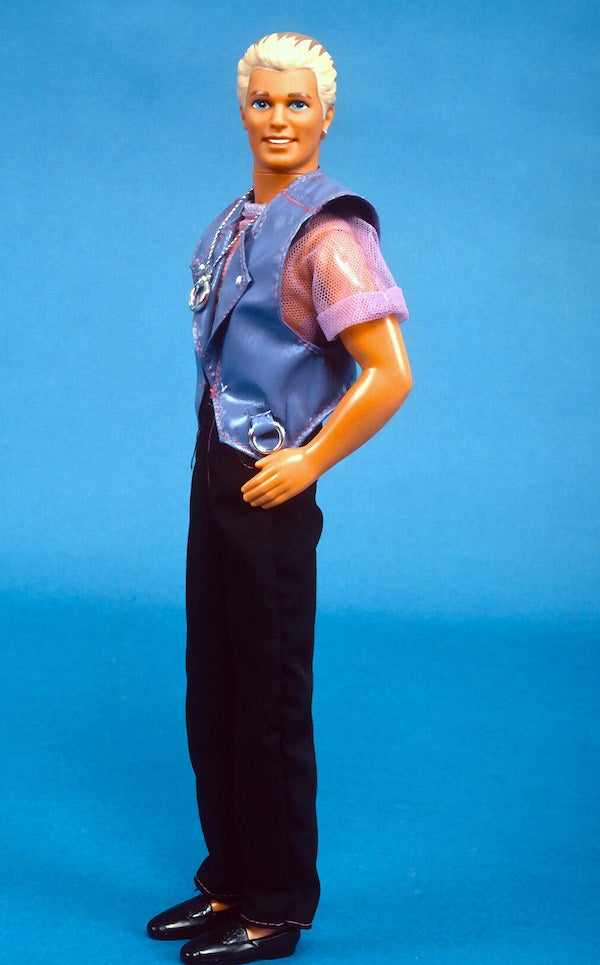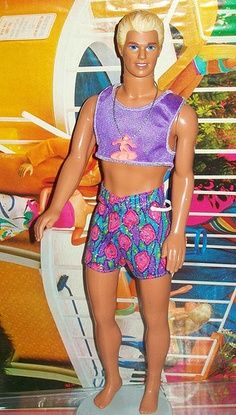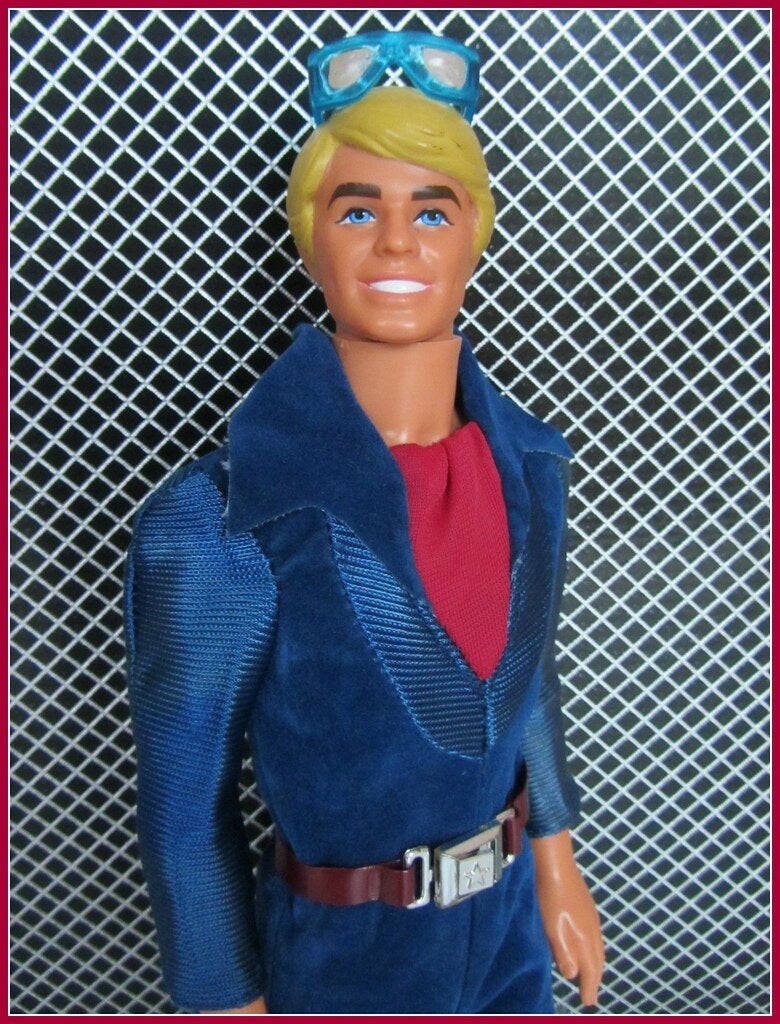To help get you into the spirit of the season, this week we’re presenting MEL’s 2021 Holiday Toy Catalog! But instead of trying to sell you stuff like the department-store catalogs of yore, we’re offering up the little-known backstories to some of the greatest toys ever made. So take a break from your holiday shopping, grab some cocoa and be a kid again for a few minutes.
In 1990, after three decades of pretty consistent sales, toy manufacturer Mattel decided that Ken, Barbie’s oiled-up, himbo boyfriend, was in desperate need of a revamp. His blonde bombshell girlfriend was still hot shit, but hunky Ken’s popularity was waning. Mattel execs quickly gathered a focus group of five-year-old girls to tackle his declining sales, asking them the make-or-break question: Should Barbie and Ken end their relationship? Participants eventually decided Barbie’s beau could stay, but only if his style was given a serious overhaul.
Mattel’s team came back in 1993 with the now-infamous “Earring Magic Ken” doll — otherwise known as “Gay Ken” or “Cock Ring Bottom Ken,” depending on who you ask.

Long-time toy collector Cammy, known on YouTube as Darling Dollz, had seen the so-called “Gay Ken” dolls online for a while, but was clueless as to their origin story. After noticing the doll’s popularity, they started researching and released an in-depth video essay about the dolls. “The first time I remember seeing him, I didn’t understand why he was heavily known as the ‘Gay Ken,’” they tell me. “It was so weird, because he didn’t stand out to me much from all the other Kens released in his time period. They all have the potential to be Gay Ken, honestly!”
This statement checks out — when he was first released in 1961, the original Ken doll came dressed in nothing but red swim shorts and a yellow towel. Since then, he’s undergone various, gloriously camp makeovers: from the floral trunks and purple crop top of Glitter Beach Ken to the shimmery, mesh shirt of Sun Sensation Ken, this perma-tanned, 12-inch doll is basically the original metrosexual.

Earring Magic Ken was similarly camp. The design came dressed in high-waisted, hip-hugging jeans, a shimmery, lilac fishnet top and a matching lilac leather vest. His hair was highlighted blond, and his left ear — notably, not the “gay ear” — was pierced with a single, silver ring. But there was one finishing touch that sent gaydars worldwide into overdrive: a simple necklace, adorned with a big, chrome ring. To the uninitiated, it’s merely an innocent ring created to have “Barbie” and “Ken” pendants attached to it. To eagle-eyed gay guys, it was clearly a cock ring.
Shortly after “Cock Ring Bottom Ken” was released, journalist Dan Savage tracked down Mattel’s then-publicist Lisa McKendall to ask the burning question: Was the design in any way inspired by fetish-related dick jewelry? “Absolutely not. It’s a necklace,” he quotes her as responding in his alt-weekly piece “Ken Comes Out.” “It holds charms he can share with Barbie. C’mon, this is a doll designed for little girls, something like that would be entirely inappropriate.” Doubling down, she concluded: “We’re not in the business of putting cock rings into the hands of little girls!” (Mattel did not respond to my request for additional comment.)
According to Mattel ex-employee Carol Spencer, this isn’t entirely true. In her book, Dressing Barbie, she describes early 1990s Mattel as highly corporate. “The fashion design department was teeming with new employees, each of whom had been given a mandate to produce quickly and efficiently,” she writes. Although she clarifies to me that the Earring Magic line — which also consisted of four Barbie dolls and one Midge doll — was simply intended to come with a few cute earring add-ons, there were internal discussions within the company about how damn gay this specific Ken doll looked. “I do recall the male Mattel designer — who was married with several children and working on the project — saying to me: ‘They will turn Ken gay with this doll!’”
Spencer can’t recall who headed up the doll’s design, but she does bust the myth that Ken’s blond highlights are specifically queer-coded. “Articles state that his traditionally brown hair was now highlighted with blond, but his hair was not traditionally brown,” she explains. “There was a blond-haired Ken the year he was introduced, and Superstar Ken was traditionally blond.”

As for the rest of his homoerotic get-up, the rumor — which remains uncorroborated — is that Mattel employees looked to gay ravers for inspiration. “It would seem Mattel’s crack Ken-redesign team spent a weekend in L.A. or New York dashing from rave to rave, taking notes and Polaroids,” Savage wrote at the time. Here, context is key. The documentary Paris Is Burning was released in 1990, catapulting queer culture into a whole new stratosphere of popularity. Queer communities were still being decimated by the government’s inaction on the AIDS crisis, but queer aesthetics were trickling into Americans’ living rooms through massive pop-culture moments like Madonna’s Vogue and Jean Paul Gaultier’s AIDS fashion show.
Gay men couldn’t donate blood or fuck without fear, but queer culture was trendier than ever. Earring Magic Ken is seemingly an emblem of this commodification; he might look ready to huff poppers in the dark room of a club, but Mattel fiercely denied his design was, in any way, queer-coded. Yet to LGBTQ+ collectors like 39-year-old Rae Burke, the details don’t matter. Burke describes this homoerotic doll as an “accidental superstar” and a “symbol of a very specific moment in time.”
“Some gay men were out, the AIDS panic was still rampant, club culture was big and American families, especially religious ones, were scared of what all this meant for their families,” she explains. “Earring Magic Ken may not have been designed to carry a message, but he does anyhow.”
When it comes to intention, we don’t know whether this Ken was designed to look gay or not. Despite this, Burke still likes to think a handful of queer employees nudged the cock ring design past the finishing line as a horny easter egg for LGBTQ+ collectors. “It’s statistically impossible and highly unlikely that Mattel didn’t have LGBTQ+ employees, then and now, whose presence may be especially influential in design and marketing departments,” she argues.
Cock ring aside, the only evidence to suggest Earring Magic Ken is gay is that he looks gay, a theory that relies heavily on the stereotype that all gay guys are kinky, super-stylish metrosexuals.
Facts aside, the controversy seemingly made him the best-selling Ken doll ever. The rumors that the doll was pulled off the shelves following Savage’s “Ken Comes Out” article are questionable, though. Cammy believes this is a misconception; Earring Magic Ken was on the shelves for six months in total, a pretty ordinary sales window for a seasonal “fashion” doll. “Once you learn more about seasonal release schedules that fashion dolls follow, production numbers, Mattel’s sales records being private, even the way the dolls were packaged and shipped to retailers, a lot of the common narratives surrounding Earring Magic Ken and his sales numbers start to fall apart,” they tell me.
Nonetheless, there are still wholesome corners of the internet where beaming, gay collectors unbox their Earring Magic Ken dolls to marvel at his tanned abs and delight in the apparent queerness of his back story. “Barbie and Ken are iconic, whether it’s the fashion or reading non-heteronormative narratives into their design and history,” concludes Burke. “We grew up with these toys, so we’re going to adapt them to ourselves and our perspective on the world.”
And so, it doesn’t actually matter whether or not Earring Magic Ken really wears cock rings, or whether he could plausibly be fisted in the corner of a sex club. What matters is that he became an accidental queer icon during a tumultuous and evolving time for queer visibility and power, and no amount of denial on Mattel’s part could stop that. Perhaps the real “magic” of Earring Magic Ken is that — despite being robbed of any formal coming-out moment from the “no-homo” Mattel execs — the lilac-leather-clad doll still made its way into queer hearts as a horny, 12-inch legend.

